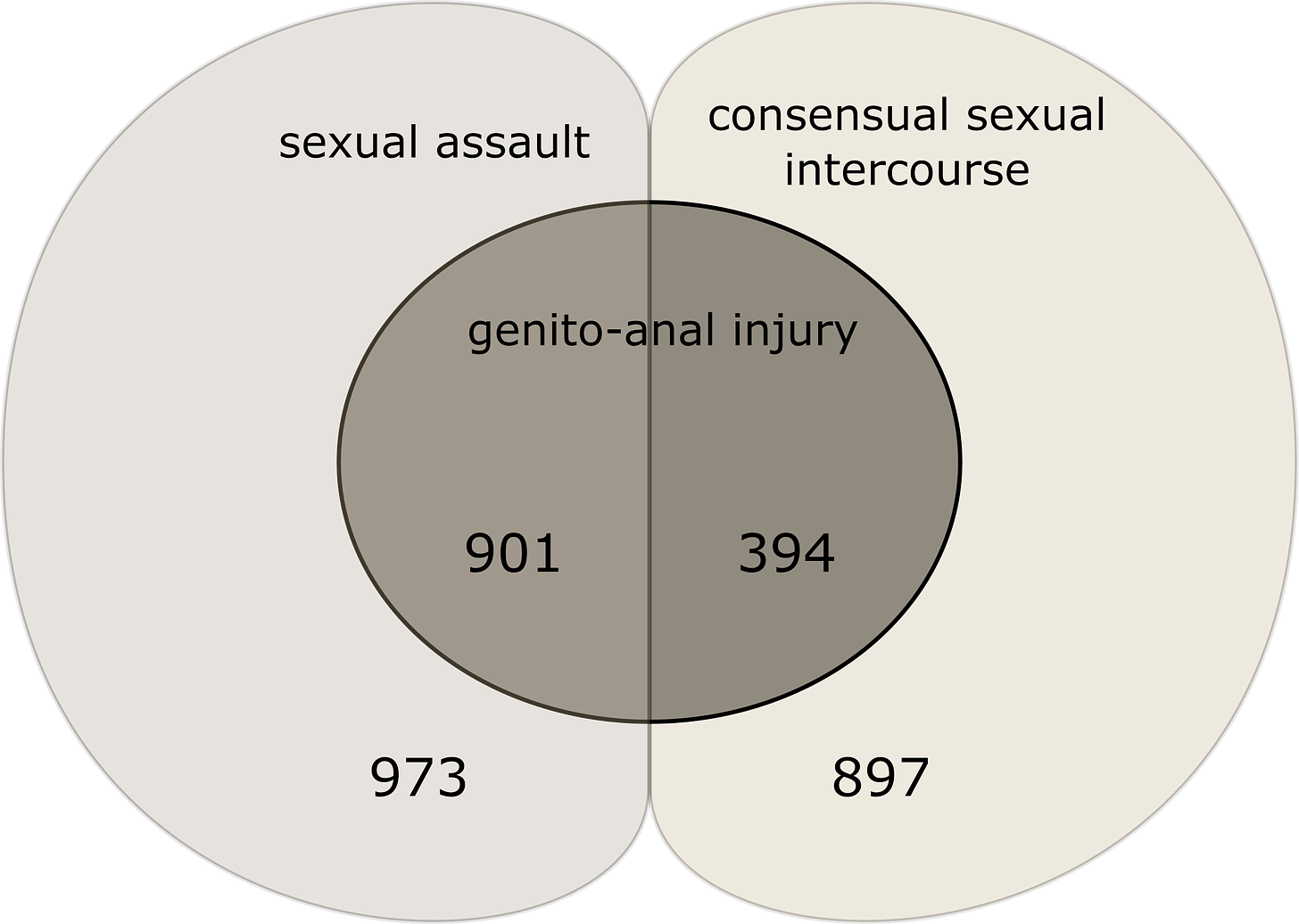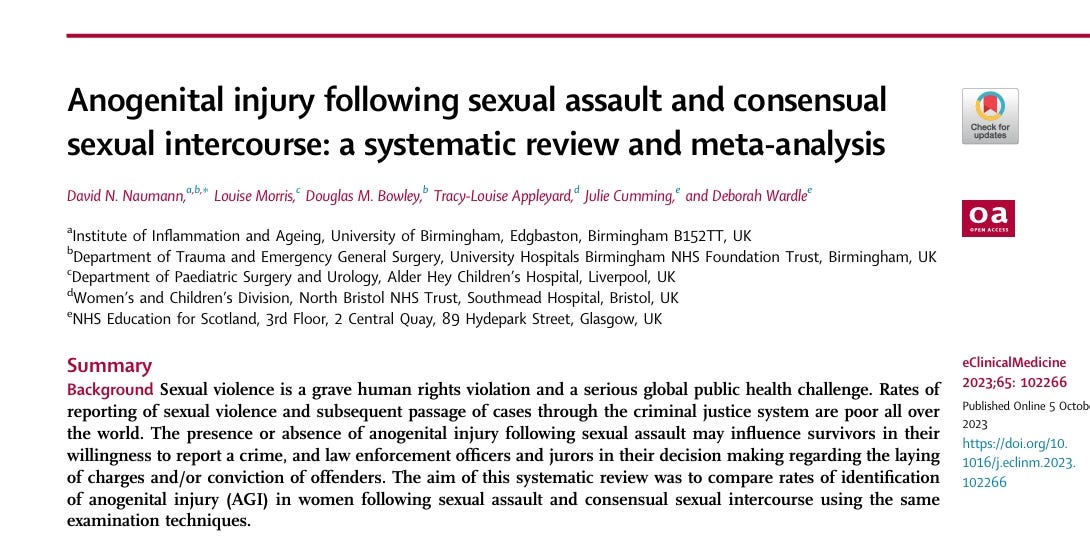On International Women’s Day 2025, women across the world are sharing our siren songs. I have chosen to share a summary of the most important research paper I have ever worked on. Published late in 2023, this research was co-authored with colleagues across the UK and led by Dr David Naumann of the University of Birmingham.
Content warning: Discussion of rape, sexual assault and related injury
1 in 4
That’s the proportion of women and girls who have been raped or sexually assaulted since the age of 16.1
In the year to September 2024, police in England and Wales recorded 199,445 sexual offences. 69,958 of these involved rape2. These numbers are increasing.
Criminal charges were brought in fewer than 3% of cases. Conviction rates are lower still. These numbers are not increasing.
In cases that reach a court of law, there is usually intense focus in cross-examination on the presence or absence of genital and/or anal injury, and on the interpretation of these injuries by medical expert witnesses. Indeed, the presence of documented injury makes conviction more likely, and its absence has led some women to disengage with the criminal justice system entirely, given the prevalence of societal stereotypes and rape myths.
But it has been well documented since the 1980s, that just as consensual sexual activity can result in bruises, abrasions or other injuries to the genital area; rape and sexual assault do not inevitably result in injury. So why, 40 years on, does the concept of lack of injury being ‘proof’ of consent - and by definition, its presence as ‘proof’ of assault - persist?
Our research paper, published in the Lancet eClinicalMedicine in late 2023, was designed to collate and analyse all relevant medical literature from the last 30 years to summarise the most definitive evidence available. We found ten studies that directly compared anal and genital clinical examination findings in 1874 women survivors of sexual assault with 1291 participants reported to have engaged in consensual sexual intercourse.

Statistical meta-analysis demonstrated that anogenital injury was more likely to be demonstrated following sexual assault than consensual activity, but importantly more than half of survivors of sexual assault have no detectable injuries. In conclusion:
The presence of anogenital injury does not prove there has been sexual assault, nor does absence of injury disprove sexual violence.
Naumann, Morris, Bowley et al, Lancet eClinicalMedicine 2023
Our work is already being cited in criminal cases. Of course, evidence relating to injury is just one element that is considered in the prosecution and defence of a sexual criminal case. Such cases are notoriously challenging to prosecute, and jury decisions often hinge on the perceived ‘credibility’ of the parties involved. It was our intent though, to ensure that medical evidence is not misinterpreted to pass undue influence.
In our detailed analysis of these ten studies dating from 1997 to 2022, we found considerable variability in study design, examination techniques and even definition of injury, though these did not meaningfully impact our conclusions.
Most concerning were the frequent problematic statements and methods within the very studies that held the best available medical evidence on forensic examination of sexual assault survivors. Authored by groups of medical and research professionals expert in the practice of health care and forensic examination of women presenting after sexual assault and rape, many of these texts carry words that in themselves are perpetuating damaging rape myths:
Almost two thirds (48/75) of the "consensual" group were women who were seen for evaluation after report of sexual assault but later "admitted to consensual sexual intercourse (confirmed by police investigation)"
"In our experience all false reports were made within 24 hours"
"Forty percent of all patients had been exposed to alcohol or other drugs during the time of assault. The history of CSI [consensual sexual intercourse] versus NCSI [non consensual sexual intercourse] may be suspect in some of these cases"
"….girls were excluded if the history of the assault was inconsistent because of intoxication or psychosocial issues"
"Recruitment to any non-consensual group is associated with difficulties confirming the veracity of an allegation, particularly when intoxication with drugs or alcohol is involved"
"Among the cases could be women passing a false or unfounded allegation of rape and thus having experience(d) either consensual intercourse or no intercourse at all. If so, there could be a bias towards a lower frequency of lesions in the case group."
(The authors do not make the converse argument that women without injury may be less likely to come forward to report their assault)
"The pattern of injuries may…bolster the survivors' credibility"
"…hymen penetration…this opening is much smaller in girls who have never engaged in sexual intercourse"
"…may result in negligible injury if prior contact sites already absorbed the force and/or there is enough lubrication and/or cooperation from the female subject"
"…assailants gave the victim alcohol or encouraged its consumption to ensure physical compliance and inability to leave the situation or call for help due to intoxication. Thus, adolescents need to receive education on the potential negative physical, mental and emotional effects of intoxicants such as alcohol in social situations"
"At minimum, adolescents, especially female subjects, need to receive education in regard to what is consent, what are their rights, and how to access resources…after they are abused or assaulted. Early sex education can help prevent adolescents from engaging in premature sexual activity, prevent anogenital injury and STIs [sexually transmitted infections], as well as to understand complicated questions of consent and choice."
Statements found in included studies - as recorded in supplementary table 4
It was particularly horrifying that:
One study included participants in their consenting group, women who presented initially with a report of sexual assault but later recanted.
Two studies describe children below the age of consent as ‘willing’ or ‘unwilling’ to categorise into consent and non-consent groups.
Medical personnel questioning credibility based on consumption of alcohol, and further placing responsibility on women and girls to modify behaviour.
So let me say this clearly:
A woman’s decision not to proceed with criminal investigation after reporting sexual assault is not an admission of consent.
Children cannot consent to sexual activity.
The only person responsible for rape is the rapist.
It is also notable that few studies included any participants with diverse ethnic backgrounds, and in fact one of the studies specifically excluded women with ‘pigmented skin’ on the basis that their skin colour made injury detection more difficult. It is known that global health inequality disproportionately impacts Black women, and it remains vital that the medical community not only acknowledge this, but work to reject racist stereotypes and ensure clinicians are properly trained to support all women.
One more time:
The absence of anogenital injury after a report of sexual assault is not proof of consent.
To read the full paper, our link is here
Misogyny persists. Across society, in the criminal justice system, in medicine and health care, and in all corners of this Earth. This International Women’s Day, we stand for women everywhere, we rewrite the narrative, we will not fall silent.
This is our siren song.
Rape, sexual assault and child sexual abuse statistics | Rape Crisis England & Wales
One in eighteen men have also been raped or sexually assaulted since the age of 16. This is of course equally abhorrent as crimes of violence against women and girls. While these crimes fall outside the scope of this essay because of the specific anatomic focus of the research literature investigated, their absence from this particular discussion does not diminish our recognition of their impact.










Louise, thank you for doing this important work and sharing your findings with us. There is so much that has to change, despite the shocking facts, I am heartened to hear that your work is being used in criminal cases. You might be interested in the brilliant post by Kay Stratton about the injustice of language (and other factors) around abuse and male violence xx
Brilliant and important work. Celebrating you today Louise!